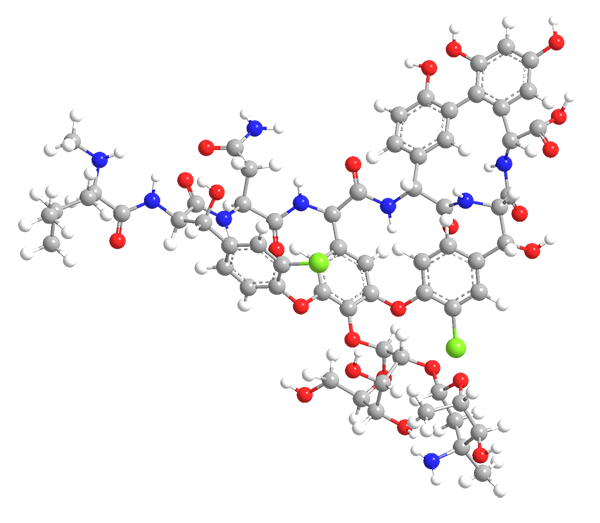What molecule am I?


Vancomycin is an amphoteric glycopeptide antibiotic produced by the soil bacterium Amycolatopsis orientalis. It is mainly used to treat serious Gram-positive bacterial infections that do not respond to other antibiotics. For most infections, it is administered intravenously because it is poorly absorbed from the gut. But it is given orally to treat some types of colitis.
In 1955, Mack H. McCormick and colleagues at Eli Lilly isolated vancomycin from A. orientalis (then called Streptomyces orientalis). Its highly complex structure was not finally determined until 1981. David A. Evans and co-workers at Harvard and K. C. Nicolaou and colleagues at the Scripps Research Institute reported the total synthesis of vancomycin in 1998 and 1999, respectively.
Vancomycin is not the answer to all antibiotic resistance problems. Some Gram-positive bacteria are intrinsically resistant to it; but more significantly, bacteria once susceptible to vancomycin are gradually becoming resistant to it, especially in hospitals and other health care institutions. Research to develop alternatives to vancomycin has been in progress for more than 20 years.
Nonetheless, vancomycin is as important as ever because it is used to treat the urgent threat of Clostridium difficile colitis and the serious threat of Staphylococcus aureus infections. For more on bacterial resistance to antibiotics, see the update on tetracycline.
MOTW Updates
Tetracycline, the widely used broad-spectrum antibiotic, was the Molecule of the Week for March 4, 2013. In this week’s Chemical & Engineering News cover story, Ann Thayer describes how a small biotech company is working to overcome bacterial resistance to tetracycline and its derivatives by synthesizing versions of the drug that overcome the major resistance mechanisms.
Enzalutamide, the Molecule of the Week for July 28, 2014, is a drug for treating refractory metastatic prostate cancer that has a convoluted history of lawsuits and changing ownerships. In the most recent episode, Pfizer outbid several competitors to acquire Medivation, a company that currently markets enzalutamide under the trade name Xtandi.

Learn more about this molecule from CAS, the most authoritative and comprehensive source for chemical information.
Molecule of the Week needs your suggestions!
If your favorite molecule is not in our archive, please send us a message. The molecule can be notable for its current or historical importance or for any quirky reason. Thank you!
Stay Ahead of the Chemistry Curve
Learn how ACS can help you stay ahead in the world of chemistry.

